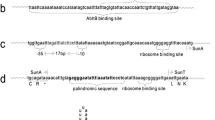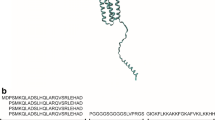Abstract
PR-FO is a novel α-helical hybrid antimicrobial peptide (AMP) with strong antimicrobial activities and high stability, and the potential to develop into a new generation of antimicrobial agents. In this study, the encoded gene sequence of SMT3-PR-FO was designed and transformed into B. subtilis WB800N. Fusion proteins with concentrations of 16 mg L−1 (SPamyQ) and 23 mg L−1 (SPsacB) were obtained after purification by a Ni–NTA resin column. A total of 3 mg (SPamyQ) and 4 mg (SPsacB) of PR-FO with a purity of 90% was obtained from 1 L fermentation cultures. Recombinant PR-FO exhibited high inhibition activities against both gram-negative bacteria and gram-positive bacteria, and low haemolytic activity against human red blood cells. These results indicated that the rSMT3-PR-FO could be expressed under the guidance of SPamyQ and SPsacB, and the maltose-induced expression strategy might be a safe and efficient method for the soluble peptides production in B. subtilis.







Similar content being viewed by others
References
Bacanli M, Başaran N (2019) Importance of antibiotic residues in animal food. Food Chem Toxicol 125:462–466
Wang JJ, Dou XJ, Song J, Lvy YF, Zhu X, Xu L, Li WZ, Shan AS (2018) Antimicrobial peptides: promising alternatives in the postfeeding antibiotic era. Med Res Rev 39:1–29
Hancock REW, Sahl HG (2006) Antimicrobial and host-defense peptides as new anti-infective therapeutic strategies. Nat Biotechnol 24:1551–1557
Lai ZH, Tan P, Zhu YJ, Shao CX, Shan AS, Li L (2019) Highly stabilized α-helical coiled coils kill gram-negative bacteria by multi-complementary mechanisms under acidic condition. ACS Appl Mater Interfaces 11:22113–22128
Tan TT, Wu D, Li WZ, Zhu X, Li WF, Shan AS (2017) High Specific selectivity and membrane-active mechanism of synthetic cationic hybrid antimicrobial peptides based on the peptide FV7. Int J Mol Sci 18:339
Ma Z, Wei D, Yan P, Zhu X, Shan A, Bi Z (2015) Characterization of cell selectivity, physiological stability and endotoxin neutralization capabilities of α-helix-based peptide amphiphiles. Biomaterials 52:517–530
Wibowo D, Zhao CX (2019) Recent achievements and perspectives for large-scale recombinant production of antimicrobial peptides. Appl Microbiol Biot 103:659–671
Winkler DFH, Tian K (2015) Investigation of the automated solid-phase synthesis of a 38mer peptied with difficult sequence pattern under different synthesis strategies. Amino Acids 47:787–794
Li Y (2013) Production of human antimicrobial peptide LL-37 in Escherichia coli using a thioredoxin-SUMO dual fusion system. Protein Expr Purif 87:72–78
Elumalai P, Park YJ, Cho M, Shea PJ, Oh BT (2018) Red yeast rice fermentation with Bacillus subtilis B2 under blue light-emitting diodes increases antioxidant secondary products. Bioproc Biosyst Eng. https://doi.org/10.1007/s00449-018-2056-3
Yang M, Zhang W, Chen Y, Gong Y (2010) Development of a Bacillus subtilis expression system using the improved Pglv promoter. Microb Cell Fact 9:1–8
Chen J, Fu G, Gai Y, Zheng P, Zhang D, Wen J (2015) Combinatorial Sec pathway analysis for improved heterologous protein secretion in Bacillus subtilis: identification of bottlenecks by systematic gene overexpression. Microbial Cell Fact. https://doi.org/10.1186/s12934-015-0282-9
Li D, Fu G, Tu R, Jin Z, Zhang D (2019) High-efficiency expression and secretion of human FGF21 in Bacillus subtilis by intercalation of a mini-cistron cassette and combinatorial optimization of cell regulatory components. Microb Cell Fact. https://doi.org/10.1186/s12934-019-1066-4
Chen J, Zhao L, Fu G, Zhou W, Sun Y, Zheng P, Zhang D (2016) A novel strategy for protein production using non-classical secretion pathway in Bacillus subtilis. Microb Cell Fact. https://doi.org/10.1186/s12934-016-0469-8
Chen J, Gai Y, Gang F, Zhou W, Zhang D, Wen J (2015) Enhanced extracellular production of α-amylase in Bacillus subtilis by optimization of regulatory elements and over-expression of PrsA lipoprotei. Biotechnol Lett 37:899–906
Lu Y, Lin Q, Wang J, Wu Y, Bao W, Lv F, Lu Z (2010) Overexpression and characterization in Bacillus subtilis of a positionally nonspecific lipase from Proteus vulgaris. J Ind Microbiol Biot 37:919–925
Zhang J, Kang Z, Ling Z, Cao W, Liu L, Wang M, Du G, Chen J (2013) High-level extracellular production of alkaline polygalacturonate lyase in Bacillus subtilis with optimized regulatory elements. Bioresource Technol 146:543–548
Parachin NS, Mulder KC, Viana AA, Dias SC, Franco OL (2012) Expression systems for heterologous production of antimicrobial peptides. Peptides 38:446–456
Kim DS, Kim SW, Song JM, Kim SY, Kwon KC (2019) A new prokaryotic expression vector for the expression of antimicrobial peptide abaecin using SUMO fusion tag. BMC Biotechnol 19:13
Malakhov MP, Mattern MR, Malakhova OA, Drinker M, Weeks SD, Butt TR (2004) SUMO fusions and SUMO-specific protease for efficient expression and purification of proteins. J Struct Funct Genom 5:75–86
Lee CD, Sun HC, Hu SM, Chiu CF, Homhuan A, Liang SM, Leng CH, Wang TF (2008) An improved SUMO fusion protein system for effecitve procuction of native proteins. Protein Sci 17:1241–1248
Bommariu B, Jenssen H, Elliott M, Kindrachuk J, Pasupuleti M, Gieren H, Jaeger KE, Hancock REW, Kalman D (2010) Post-effective expression and purfication of antimicrobial and host defense peptides in Escherichia coli. Peptides 31:1957–1965
Motejadded H, Altenbuchner J (2009) Construction of a dual-tag system for gene expression, protein affinity purification and fusion protein processing. Biotechnol Lett 31:543–549
Yang M, Zhang W, Ji S, Cao P, Chen Y, Zhao X (2013) Generation of an artificial double promoter for protein expression in Bacillus subtilis through a promoter trap system. PLoS ONE 8:e56321
Jorgensen S, Vorgias CE, Antranikian G (1997) Cloning, Sequencing, Characterization, and expression of an extracellular-amylase from the hyperthermophilic archaeon pyrococcus furiosus in Escherichia coli and Bacillus subtilis. J Biol Chem 272:16335–16342
Caimi PG, Mccole LM, Klein TM, Kerr PS (1996) Fructan accumulation and sucrose metabolism in transgenic maize endosperm expressing a Bacillus amyloliquefaciens SacB gene. Plant Physiol 110:355–363
Ilk N, Schum CT, Bohle B, Egelseer EM, Sleytr UB (2011) Expression of an endotoxin-free S-layer/allergen fusion protein in gram-positive Bacillus subtilis 1012 for the potential application as vaccines for immunotherapy of atopic allergy. Microb Cell Fact 10:1–12
Stark M, Liu LP, Deber CM (2002) Cationic hydrophobic peptides with antimicrobial activity. Antimicrob Agents Ch 46:3585–3590
Shao C, Li W, Tan P, Shan A, Dou X, Ma D, Liu C (2019) Symmetrical modification of minimized dermaseptins to extend the spectrum of antimicrobials with endotoxin neutralization potency. Int J Mol Sci 20:1417
Zhang L, Li G, Zhan N, Sun T, Cheng B, Li Y, Shan A (2019) Expression of a Pseudomonas aeruginosa-targeted antimicrobial peptide T9W in Bacillus subtilis using a maltose-inducible vector. Process Biochem 81:22–27
Zhu X, Dong N, Wang Z, Ma Z, Zhang L, Ma Q, Shan A (2014) Design of imperfectly amphipathic α-helical antimicrobial peptides with enhanced cell selectivity. Acta Biomater 10:244–257
Veldhuizen EJA, Brouwer EC, Schneider VAF, Fluit AC (2013) Chicken cathelicidins display antimicrobial activity against multiresistant bacteria without inducing strong resistance. PLoS ONE 8:e61964
Li Y (2011) Recombinant production of antimicrobial peptides in Escherichia coli: a review. Protein Expres Purif 80:260–267
Zhang L, Li X, Wei D, Wang J, Shan A, Li Z (2015) Expression of plectasin in Bacillus subtilis using SUMO technology by a maltose-inducible vector. J Ind Microbiol Biotechnol 42:1369–1376
Gimenez GG, Costa H, de Lima Neto QA, Fernandez MA, Ferrarotti SA, Matioli G (2019) Sequencing, cloning, and heterologous expression of cyclomaltodextrin glucanotransferase of Bacillus firmus strain 37 in Bacillus subtilis WB800. Bioproc Biosyst Eng. https://doi.org/10.1007/s00449-018-02068-4
Nguyen TT, Quyen TD, Le HT (2013) Cloning and enhancing production of a detergent- and organic-solvent-resistant nattokinase from Bacillus subtilis VTCC-DVN-12-01 by using an eight-protease-gene-deficient Bacillus subtilis WB800. Microb Cell Fact 12:79
Chityala S, Venkata DV, Ahmad J, Prakasham RS (2015) High yield expression of novel glutaminase free l-asparaginase II of Pectobacterium carotovorum MTCC 1428 in Bacillus subtilis WB800N. Bioproc Biosyst Eng 38(11):2271–2284
Sun H, Bie X, Lu F, Lu Y, Wu Y, Lu Z (2009) Enhancement of surfactin production of Bacillus subtilis fmbR by replacement of the native promoter with the Pspac promoter. Can J Microbiol 55(8):1003–1006
Chen J, Zhu Y, Fu G, Song Y, Jin Z, Sun Y, Zhang D (2016) High-level intra- and extra-cellular production of d-psicose 3-epimerase via a modified xylose-inducible expression system in Bacillus subtilis. J Ind Microbiol Biotechnol 43(11):1577–1591
Phan HTT, Nhi NNY, Tien LT, Phuong CTB, Ngan LTP, Trang PPT, Nguyen HD (2019) Construction of expression plasmid for Bacillus subtilis using Pspac promoter and BgaB as a reporter. Nat Sci 22:239–246
Luan C, Zhang HW, Song DG, Xie YG, Feng J, Wang YZ (2013) Expressing antimicrobial peptide cathelicidin-BF in Bacillus subtilis using SUMO technology. Appl Microbiol Biot 98(8):3651–3658
Wang Y, Liu Y, Wang Z, Lu F (2014) Influence of promoter and signal peptide on the expression of pullulanase in Bacillus subtilis. Biotechnol Lett 36:1783–1789
Fu G, Liu JL, Li JS, Zhu BW, Zhang DW (2018) Systematic Screening of optimal signal peptides for secretory production of heterologous proteins in Bacillus subtilis. J Agric Food Chem 66:13141–13151
Zhang W, Yang M, Yang Y, Zhan J, Zhou Y (2016) Zhao X (2016) Optimal secretion of alkali-tolerant xylanase in Bacillus subtilis by signal peptide screening. Appl Microbiol Biotechnol 100:8745–8756
Acknowledgements
We gratefully acknowledge the financial support from the National Natural Science Foundation of China [31672434, 31872368, 31472104], the Natural Science Foundation of Heilongjiang Province [TD2019C001], and the China Agriculture Research System [CARS-35].
Author information
Authors and Affiliations
Corresponding author
Ethics declarations
Conflict of interest
The authors have declared no conflict of interest.
Additional information
Publisher's Note
Springer Nature remains neutral with regard to jurisdictional claims in published maps and institutional affiliations.
Rights and permissions
About this article
Cite this article
Zhang, L., Wei, D., Zhan, N. et al. Heterologous expression of the novel α-helical hybrid peptide PR-FO in Bacillus subtilis. Bioprocess Biosyst Eng 43, 1619–1627 (2020). https://doi.org/10.1007/s00449-020-02353-1
Received:
Accepted:
Published:
Issue Date:
DOI: https://doi.org/10.1007/s00449-020-02353-1




